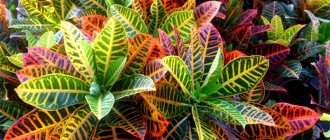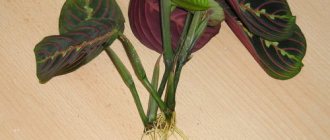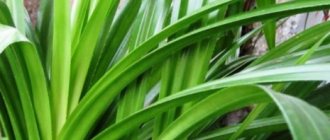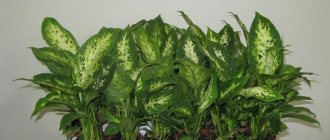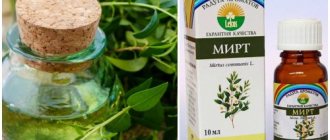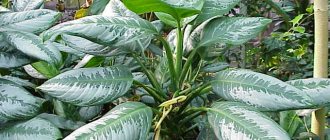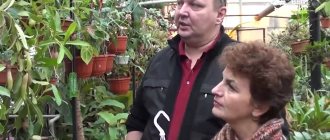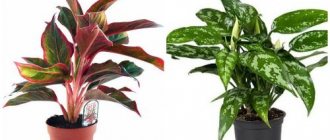They name this houseplant differently, often giving it the names of other potted plants that are similar in appearance (elephant's foot, bottle tree, horse or ponytail). It should be correctly called “bocarnea” or “nolina”. Everyday care at home for this indoor flower will not require much effort, since in its homeland it is not spoiled by nature, surviving in harsh places where rain happens once or twice a year. Thanks to its unusual shape, it has a spectacular appearance that fits harmoniously into almost any modern interior, especially high-tech and fusion, giving it a special tropical “zest.”
general description
The plant belongs to the agave family of succulents and is capable of accumulating large amounts of moisture for future use thanks to the trunk, which is strongly swollen in the lower part.
Moisture consumption is also controlled by the crown, formed from narrow belt-shaped leaves. In drought and extreme heat, the rosette shrinks into a bunch, further reducing the evaporating surface. In its homeland (USA and northern Mexico), under favorable conditions, it forms a tall tree, from the lower very thick bottle part of which several trunks grow, topped with picturesque flowing rosettes of leaves. In indoor conditions, you can grow a tree 0.5 m high in 5-6 years.
Branching usually occurs after flowering, which is extremely difficult to achieve at home. However, Dutch seedling growers achieve the desired branching by skillful pruning. This takes more than one season, so buying a finished copy is very expensive. More often, young seedlings with bulbous stem shoots go on sale.
The thickening of the trunk is called the caudex. Not only rare rainwater collects here, but also morning dew, which flows into the caudex along the grooved leaves.
Common types
Of the three dozen natural varieties in culture, the following species are most widespread.
Beaucarnea rejected
The most common variety of “bottle tree”, which has a classic shape. Lightweight and undemanding to care for, it was cultivated back in the 19th century. It has very durable leaves, which in Mexico are used as material for weaving national sombrero hats.
Beaucarnea condensed
It is valued by home gardeners for its lush, spectacular crown with straight, hard leaves. The second most popular cultivated species. Relatively winter-hardy, withstands short-term temperature drops down to -5C.
The thickening of the trunk in this variety is weakly expressed, the leaves have a bluish tint. In Mexico, this species is called bear grass. Winter hardiness is high, up to -12C.
Nolina Lindemeira
The shortest, practically without a trunk. The leaves are very thin, cord-like, dry and hard.
Nolina thin (slender)
The name of this species sounds like irony, since the thickness of the trunk is a record holder in terms of volume - in the wild in the lower part it reaches 5-7 m. It blooms only in adulthood and only in natural conditions.
Fine gravel or colored pebbles poured into a pot will prevent the formation of a soil crust and emphasize the exoticism of the crop.
How to care for nolina?
Care at home should be carried out taking into account the fact that the plant is a pronounced succulent.
Choice of location, lighting
While the majority of even light-loving indoor plants require light shading during hot midday hours from direct sunlight, nolina tolerates them calmly, so it should be placed on the brightest, southern windowsill. A little partial shade during the day will not be critical for it. However, the less light the foliage receives, the less lush it will grow. During the winter season, windowsills facing east and north require additional lighting.
Soil requirements
If bocarneya is completely undemanding in terms of soil nutrition, then it makes high demands on its moisture permeability and aeration. In the wild, it has to make do with infertile soils on rocky slab foundations, so growing nolina at home needs to be as close to them as possible. At the same time, the plant grows very slowly, so to obtain faster results, favorable conditions should be created that do not contradict the biological characteristics of the bottle tree. The substrate is made up of leaf and turf soil with a predominance of the former, peat and sand. You can add a little humus. Heavy drainage is installed at the bottom of the pot to stabilize the container. It is not recommended to use expanded clay for this purpose if the height of the dishes is not commensurate with the height of the tree.
How to water?
The issue of watering is key when growing nolina. If you place it on a southern windowsill and water it very rarely, with considerable exposure after the earthen ball has completely dried out, a stressful situation will be created, similar to growing in its homeland. In response, the plant will begin to form a thick “leg” with decorative cracks and scars that appear from the uneven expansion and contraction of the outer tissues. But the leaf rosette will begin to thin out and may droop, which will be to the detriment of decorativeness. To maintain a harmonious appearance, balance must be found. Spraying is usually not necessary for the crop, but occasional wet treatment of the leaves will be beneficial.
Bottom watering through a tray is recommended. The water should be well settled or filtered, without traces of chlorine.
Bocarnea loves summer sun-air baths outside in dry and windless weather.
During the winter season, the plant has an unexpressed dormant period; there is no need to water it at this time; it is enough to occasionally moisten the leaves by wiping them with a damp sponge to remove dust.
Top dressing
Since the vegetative mass accumulates slowly, care should be taken to ensure that there is no excess nitrogen in the soil. This element causes soft leaves and their sagging, which negatively affects the decorative effect. Occasionally, and only in the warm season, the specimen can be fed with a liquid phosphorus-potassium complex in half the recommended dose.
Temperature
Bocarnea loves warmth and does well even in hot conditions. But she needs rest and a relative rest phase during the winter season. It is desirable that the temperature at this time remains within +15C or does not differ from this indicator by more than 5⁰.
Crown formation
The form nolina will take depends on the conditions under which it is kept. Unlike other indoor exotic trees, the question is not how to prune bokarnia to give it the desired shape, but how to water it and where to place it. If you place the pot further from the light source and create extreme watering conditions, it will grow a “leg”. Placing it in a bright place and moisturizing more frequently will stimulate hair growth. The trunk can be completely straight. This adjustment can give the specimen the desired shape.
Watering
At the base of Nolina there is a thick, swollen stem that has a woody appearance. It is a water storage organ that can support the plant during drought. This characteristic feature in the flower description should indicate to you that the plant is ready for long periods between waterings. An excellent houseplant for those who enjoy peace of mind and low maintenance.
Tip: If you grow your flower in a very small pot with little soil, it will dry out faster and may need more frequent watering, this is an important detail in how to water your flower.
Ideally, you should aim to water at least a few times a month (once a week in high summer if possible), and make sure it's a thorough watering.
Water supplies will support the plant if you forget to water it from time to time, but don't make it a habit or you'll end up with a struggling plant rather than a thriving one.
Transfer
Containers with several copies of seedlings usually go on sale. They require placement in separate containers. But there is no need to strive to transplant Nolina as quickly as possible after purchase. It should be replanted only after a week (at least) period of quarantine and adaptation to new conditions.
The roots require careful handling, so if possible, seedlings should be transferred by transshipment. After the plant is transplanted into a new container, a bag is put on it, leaving access to fresh air. It does not need to be removed until signs of leaf growth appear.
Domestic specimens require replanting approximately once every 3 years, but you should focus on the root system; by this time it should completely occupy the volume of the dish. An external sign of the need for housewarming is the cessation of leaf growth. The procedure remains the same.
Important! The thickened part must not be buried! The stem should remain in the ground at the same level.
Requirements for dishes
The roots of nolina, despite the arid conditions of wild growth, grow not in depth, but in breadth due to the shallow fertile layer of rocky soils. For this reason, she needs to select wide and fairly small bowls, paying special attention to their stability. Sometimes, for this purpose, several heavy stones are placed at the bottom of the pot, which additionally perform the drainage function that is extremely necessary for the plant.
When replanting older specimens, the diameter of the container is increased by 4 cm each time.
When transplanting, nolina is not watered! The plant is not able to absorb moisture in a state of adaptation; it will remain in the soil and lead to rotting of the roots.
Light
These plants will grow slowly and although will do well in a slightly shaded location, they need bright light to thrive. If you provide some sun, within a few weeks you will see the plant turn this into lush new leaves, meaning more light means more growth.
Nolina plants grown in the shade should not be suddenly moved and thrown into a very sunny location. Move the plant to this new location for a few hours a day and then back again. Do this for a week to get used to the change in light intensity. This will prevent the leaves from becoming disfigured.
How does nolina reproduce?
In home floriculture, bokarnia can be propagated both by seeds and by lateral layering.
Reproduction by lateral shoots
The planting material is the sprouts that form on the trunk. They should be carefully broken off and rooted in a moist (but not wet!) peat-sand substrate with the addition of perlite. In the compacted soil, a peg is used to make a depression in which the sprout is placed and the earth is carefully pressed down around it. The top of the planting is covered with glass or a plastic bag, leaving access to air. The temperature is maintained within +21…+26C. Ventilation and spraying are carried out daily. As soon as new leaves begin to appear, the cover is removed and the seedling begins to accustom itself to the usual conditions of keeping adult plants.
Growing nolina from seeds
Before sowing bocarnea seeds, they need to be soaked in warm water for a couple of days. Adding Epina to water gives good results. The finished seeds are laid out on the compacted surface of the substrate, after which they are sprinkled with a layer of earth, the thickness of which should be equal to the size of the seeds. The container is placed in a warm place where the planting is provided with a constant temperature (approximately +20C) and humidity. You can expect germination in a month. After the seedlings have grown stronger, they are planted in separate containers. For the first time, you can plant 3-4 seedlings in one container.
Possible problems during cultivation
- The trunk does not thicken, but grows upward. The reason is lack of lighting and too frequent watering. It is necessary to move the plant to a bright place and practice regular but moderate dry periods.
- The leaves of the lower tier dry out and fall off. The situation is not problematic because a natural process is taking place. It is better not to tear off dried leaves, but carefully trim them with sharp scissors.
- The ends of the leaves dry out. Despite the plant's drought resistance, it sometimes suffers from excessive dry air, since it is naturally moistened by morning dew. The problem especially often occurs in winter when kept in a room with central heating. Help - light spraying with soft, settled water without chlorine. The first time is every day early in the morning.
- The trunk shrinks, decreases in volume and dries out. Usually this process is observed after a long winter, in this case it is natural. In spring, the tree will begin to accumulate moisture again.
- The leaves become soft and do not form a beautiful “hair”. The reason is an excess of nitrogen in the soil.
- Leaves that are not located at the bottom of the rosette dry out, or all the foliage becomes paler. This could be a sign of dangerous root rot. The reason may be excessive watering, especially in the cold season, as well as drafts, which bokarneya is very afraid of. If root rot is suspected, the plant should be removed and the roots examined. Rotten parts are carefully removed. If rot has affected the trunk, the damaged part should be cut out and the cut should be sprinkled with ash. If the area of the rotten part is large, the plant will most likely die.
Diseases and pests
This representative of the flora is not susceptible to pests due to its tough leaves. Diseases appear only with improper care.
If the tips of the leaves begin to dry, and the caudex is severely depleted , the plant does not have enough moisture and the flower is in a depressed state.
It is necessary to increase watering and spraying. Also, leaves may dry out during the dormant period. In this case, you just need to wait until spring.
Falling to one side indicates that the soil is too loose and cannot support the weight of the plant.
This flower needs support.
Also, with a lack of light, the plant may reach towards the sun. Therefore, Nolina is periodically turned 90°.
Nolina is a flower that tolerates drought well thanks to its caudex. For active growth, the flower requires drought and wet periods. The flower loves bright lighting, shallow dishes and spraying. Propagated by vegetation and seeds. It grows very slowly.
The reader may be interested in the following materials about the plant:
- Nolina plant (Bokarneya): description, types, care.
- “Nolina Recurvata” (Bocarnea Bent): features of care.

